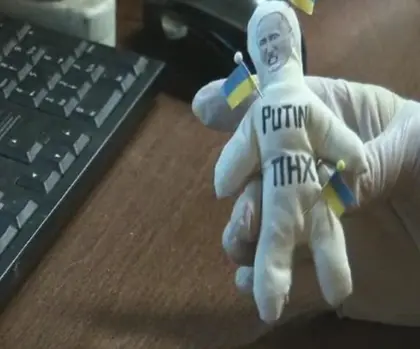The project was launched by a group of activists who call themselves Voodoo Politics and who do not want to reveal their names. Mary Mycio, who agreed to be their public face, compares Voodoo Politics team with the “little green men” of anti-Putinism.
The term “little green men” or “polite green men” was coined when Russian troops, dressed in uniforms with no insignia, started to take over the Crimean peninsula earlier this year. Later those men out to be the regular troops of the Russian army, but the terms became memes.
JOIN US ON TELEGRAM
Follow our coverage of the war on the @Kyivpost_official.
Several months later the term “vatnik” also appeared. Originally, it used to mean a padded or quilted jacket, but now it refers to Russia supporters who might be a little too thick to see through the Russian propaganda. It’s also used to refer to insurgents in the east of Ukraine.
“If Putin can deny that he is backing the “vatniks” in the east and Crimea, then Voodoo Politics can deny having anything to do with the VATNIK project”, Mycio explains. “It’s partly a joke”.
Mycio says she agreed to be a public face for the group due to her activity on social networks and previous experience with Kickstarter projects. Having Ukrainian heritage, she quit her job as a lawyer in America and moved to Ukraine in 1991 where she spent 16 years, working as a Los Angeles Times reporter and directing a legal aid program for Ukrainian journalists.
Upon returning to the US, she wrote books about her experience in the country, focusing on Chornobyl, and helped raise funds for a documentary about it. Since the documentary project got full support on Kickstarter, Mycio continued her work helping Voodoo Politics and seeking finances for the Putin doll.
“The main idea of the project is to mock Putin and help the (Ukrainian) army”, Mycio explains.
She says it is a form of a weaponizing humor that can be very potent in the information wars.
“We also think the VATNIKs are hilarious”, Mary adds, “And we really enjoyed making the VATNIK destruction videos that are part of the Kickstarter campaign.”
The videos portray dolls being destroyed in funny ways. For instance, they show a cat biting Putin’s head off or a dinosaur toy “eating” it.
In less than a week, the project collected almost $1,000. Now, the team has three more weeks to raise the rest of the money.
“The Kickstarter (pitch) is intended to raise the money needed to produce enough dolls to test the market demand,” Mycio explains. “Some money will also go to develop a website and launch a modest marketing campaign.”
The group aims to raise $5,185 to produce 500 dolls. Mycio adds that if the campaign succeeds, part of the proceeds from sales will be donated to the Ukrainian army, in particular, the 92nd Mechanized Brigade. If the product is commercially successful, it will provide a steady stream of donations to the army.
The team hopes to get a lot of donations from Ukraine, even if they are $1 only.
“The Kickstarter is also a kind of performance art,” Mycio says. “If the project gets massive support, it will be a political statement”.
Editor’s Note: This article has been produced within Journalism Exchange Program supported by international media project MyMedia (www.mymedia.org.ua), and implemented by a non-governmental organization Media Development Foundation, founded by a group of Kyiv Post journalists.
You can also highlight the text and press Ctrl + Enter



